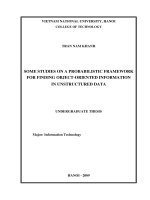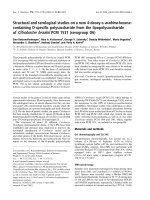Genetic studies on a soil streptomyces sp that produces an antifungal compoud
Bạn đang xem bản rút gọn của tài liệu. Xem và tải ngay bản đầy đủ của tài liệu tại đây (3.76 MB, 232 trang )
GENETIC STUDIES ON A SOIL STREPTOMYCES SP.
THAT PRODUCES AN ANTIFUNGAL COMPOUND
NACHAMMA SOCKALINGAM
BSc (Hons), NUS
NATIONAL UNIVERSITY OF SINGAPORE
2002
GENETIC STUDIES ON A SOIL STREPTOMYCES SP.
THAT PRODUCES AN ANTIFUNGAL COMPOUND
NACHAMMA SOCKALINGAM
BSc (Hons), NUS
A THESIS SUBMITTED
FOR THE DEGREE OF MASTER OF SCIENCE
DEPARTMENT OF MICROBIOLOGY
NATIONAL UNIVERSITY OF SINGAPORE
2002
ACKNOWLEDGEMENTS
I would like to thank my supervisors
A/P Nga Been Hen and
A/P Vincent Chow Tak Wong
for their supervision, guidance and
motivation
My thanks to all the faculty members of
Department of Microbiology
My heartfelt gratitude to Dr. Fiona Flett
and Dr. Colin Smith of UMIST for their kind
gift of the E.coli strainET12567
I would also like to thank my family, with
a special mention of Vignes and Ramesh for
their endless support.
I would also like to thank my wonderful
friends who have been there to discuss
science,life and for fun, just about
everything else. Special Thanks to
Baskar,Dhira,Karen,Kokila, Kahmeng and
Sunita.
INTRODUCTION
LITERATURE REVIEW
MATERIALS AND METHODS
RESULTS
DISCUSSION
REFERENCES
TABLE OF CONTENTS
TABLE OF CONTENTS
i
LIST OF FIGURES
vi
LIST OF TABLES
ix
ABBREVIATIONS
x
SUMMARY
xii
1. INTRODUCTION
1
2. LITERATURE REVIEW
3
2.1
Antibiotics
3
2.2
Antifungal Compounds
4
2.3
2.2.1
Need for Antifungal Compounds
2.2.2
Existing Antifungal Compounds
2.2.3
Search for Novel Antifungal Compounds
Antibiotics Producing Organism
7
2.3.1 Actinomycetes: Growth and Nutrient Requirements
2.4
2.5
2.6
2.3.2
Actinomycetes: Classification
2.3.3
Streptomycetes
2.3.4
Streptomycetes: Secondary Metabolism and Differentiation
2.3.5
Streptomyces: Genome and Antibiotic Synthesis
Polyketides
2.4.1
What are polyketides?
2.4.2
Aromatic and Complex Polyketides
2.4.3
Structure and Function of Polyketides
2.4.4
Historical Perspective of Polyketides
Fatty Acid and Polyketide Synthases
2.5.1
Fatty Acid Synthases
2.5.2
Polyketide Synthases
Discovery of Polyketide Synthases
2.6.1
Erythromycin Polyketide Synthase Genes
2.6.2
Domain Identification of Erythromycin Polyketide
15
18
23
Synthase Genes
2.6.3
Enzymology of Erythromycin Polyketide Synthase Genes
2.6.4
The Programming Model and Proof of Function
i
2.7
2.8
2.9
Other Modular Polyketide Synthases
2.7.1
Spiramycin
2.7.2
Rapamycin
2.7.3
Candicidin
2.7.4
Soraphen
Elucidation of Biosynthetic Process of Polyketides
2.8.1
Identification of Building Blocks
2.8.2
Isolation of Intermediates
2.8.3
Identification of Enzymes
2.8.4
Identification of Genes
Strategies for cloning Polyketide Synthase Genes
2.9.1
Complementation of Mutants
2.9.2
Search for Homologous Genes
2.9.3
Protein Isolation Followed by Gene Cloning
2.9.4
Expression of Secondary Metabolism Genes and
30
33
37
Gene Clusters
2.9.5
2.10
Genome Sequencing
Proof of Function of Cloned Polyketide Synthase Genes
41
2.10.1 Gene Disruption
2.10.2 Gene Replacement
2.10.3 Gene Disruption Vectors
2.10.4 DNA Manipulation in Gene Disruption
3.MATERIALS AND METHODS
48
3.1
48
Preparation of Organisms
3.1.1 Streptomyces
3.2
3.1.2
Escherichia coli
3.1.3
Aspergillus niger
Preparation of Chromosomal and Plasmid DNA
53
3.2.1 Isolation of Streptomyces Total DNA
3.2.2
Plasmid Isolation from E. coli
3.2.3
Spectrophotometric Determination of DNA
3.2.4 Agarose Gel Electrophoresis of DNA
3.3
In Vitro Manipulation of DNA and Cloning
3.3.1
57
Restriction of DNA
ii
3.3.2
Alkaline Phosphatase Treatment
3.3.3
Recovery of DNA Fragments from Gel
3.3.4
Ligation
3.3.5 pGEMT- T Easy Vector System
3.3.6
Transformation and Selection of Competent DH5α or
Top10 E. coli Cells
3.3.7
Transformation and Selection of Competent ET12567
E. coli Cells
3.3.8
3.4
Analysis of Recombinant Clones
Intergeneric Conjugation
61
3.4.1 Conjugation
3.4.2
Soft Agar Overlay to Select for Resistant Conjugants
3.4.3 Analysis of Conjugants
3.5
Techniques using DNA
3.5.1
Southern Hybridisation
3.5.2
Polymerase Chain Reaction
62
3.5.3 Sequencing
3.6
Biocomputing Software
70
3.7
Compound Extraction and Analysis
71
3.8
3.7.1
Compound Extraction
3.7.2
Thin Layer Chromatography
3.7.3
Bioassay
Bacterial strains and media
3.8.1
Agar/ Liquid Media
3.8.2
Antibiotic Concentrations
3.8.3
Strains of Streptomyces, E. coli and Aspergillus used
3.8.4
Plasmids Used
3.8.5
Probes Used
3.8.6
DNA Modifying Enzymes Used
3.8.7
DNA Size Standards
3.8.8
Common Solutions and Buffers
73
iii
4
RESULTS
82
4.1
Identification of the Streptomyces sp. 98- 62
82
4.2
4.1.1
Polymerase Chain Reaction
4.1.2
Sequence of 16S rDNA from the Streptomyces sp. 98- 62
Preliminary Evidence of PKS I Compound Production by the
Streptomyces sp. 98- 62
4.3
4.4
4.2.1
Southern Hybridisation Using PKS I Specific Probe
4.2.2
Analysis of Secondary Metabolites
Cloning of KS/AT Genes from the Streptomyces sp. 98- 62
4.3.1
Amplification, Cloning and Sequencing of KS/AT Genes
4.3.2
Sequence of KS/AT Genes
4.3.3
Aminoacid Sequence Comparison of the KS/AT Genes
92
Southern Hybridisation Using KS/AT Genes of the Streptomyces sp.
98- 62
4.5
87
94
Subgenomic Library Construction and Screening for Clones Containing
the KS/AT Genes
4.5.1
Subgenomic Library Construction
4.5.2
Screening for Clones Containing the KS/AT Genes
97
4.6
Restriction and Sequence Analysis of the Clone C170
99
4.7
Chromosomal Walking
102
4.8
Subgenomic Library Construction and Screening for Clones Containing
the Genes Downstream to the Insert Fragments of Clone C170
4.8.1
Subgenomic Library Construction
4.8.2
Screening for Clones Containing the Downstream Genes
4.9
Restriction and Sequence Analysis of the Clone C2
4.10
Subgenomic Library Construction and Screening for Clones Containing
the Genes Upstream to the Insert Fragments of Clone C170
104
106
109
4.10.1 Subgenomic Library Construction
4.10.2 Screening for Clones Containing the Upstream Genes
4.11
Restriction and Sequence Analysis of the Clone E27
4.12
Restriction and Sequence Analysis of the Overlapping Clones
C2, C170 and E27
111
114
4.12.1 Sequence of the Overlapping Clones
4.12.2 Sequence Analysis of the Overlapping Clones
iv
4.13
Setting Up of a Gene Disruption Experiment
130
4.13.1 Gene Disruption: Choice of Vector and Donor E. coli Strain
4.13.2 Disruption Constructs
4.14
Gene Disruption Using a Disruption Construct with Stop/Start Codons
141
4.14.1 Proof of Physical Disruption
4.14.2 Proof of Non-functional Disruption
4.15
Gene Disruption Using Disruption Constructs of Internal Fragments
149
4.15.1 Phenotype of Disruptants
4.15.2 Proof of Physical Disruption
4.15.3 Proof of Functional Disruption
5. DISCUSSION
155
6. REFERENCES
191
v
LIST OF FIGURES
Num Title
Page
1
Diverse Structures and Functions of Polyketides
17
2
Mechanism of Fatty acid and Polyketide Synthesis
20
3
Organisation of the Various PKS I genes
22
4
Organisation of the Various PKS II genes
23
5
Open Reading Frames of Erythromycin Biosynthetic Gene
Cluster
25
6
The Proposed Mechanism of Erythromycin Biosynthesis
29
7
16S rDNA of the Soil Isolate 98- 62
83
8
Sequence Comparison of the 16S rDNA of the Soil Isolate 98- 62
84
9
Phylogenetic Analysis of 16S rDNA of the Soil Isolate 98- 62
86
10
Electrophoretic Profile of the Soil Isolate 98- 62 genomic DNA
88
11
Southern blot of Restriction Endonuclease Digested Chromosomal
DNA Using PKS I Specific Probe
89
12
TLC Chromatogram and Overlay Assay of the Extracts of Pure FK506
91
13
Sequence of KS/AT Genes Amplification Product from the Soil Isolate
98-62
93
14
Sequence Comparison of the KS/AT Genes with Genbank Sequences
93
15a
Electrophoretic Profile of Endonuclease Digested Chromosomal
DNA Samples
15b
96
Southern Blot of the Endonuclease Digested Chromosomal DNA
Samples Using KS/AT Genes Probe
96
16a
PCR Screening of Pool DNA for Clones Containing KS/AT genes
98
16b
PCR Screening of Individual Clones Containing KS/AT genes
98
17a
Restriction Profile of the Clone C170
101
17b
Restriction Map of the Clone C170
101
18a
Southern Blot of the Restriction Endonuclease Digested Chromosomal
DNA Samples Probed with 3.7kb SphI/BamHI Probe
18b
Southern Blot of the Restriction Endonuclease Digested Chromosomal
DNA Samples Probed with 1.5kb SphI/BamHI Probe
19a
103
103
PCR Screening of Pool DNA to Identify Pool Containing Clone
Downstream to Insert Fragment of the Clone C170
105
vi
19b
PCR Screening of Pool DNA to Identify Pool Containing Clone
Upstream to Insert Fragment of the Clone C170
20a
105
Restriction Profile of the Clone C2 Digested with Different Restriction
Enzymes
108
20b
Restriction Map of the Clone C2
108
21a
PCR Screening of Pool DNA to Identify Pool Containing Clone
Upstream to Insert Fragment of the Clone C170
21b
Colony PCR Screening of Individual Clones to Identify Clone
Upstream to Insert Fragment of the Clone C170
22a
110
110
Restriction Profile of the Clone E27 Digested with Different Restriction
Enzymes
113
22b
Restriction Map of the Clone E27
113
23
Nucleotide Sequence of the Clones E27, C170 and C2
116
24
Restriction Map of the Genomic Region of the Soil Isolate 98- 62
Cloned in Three Contiguous Clones Clone E27, Clone C170 and
Clone C2
25
117
Sequence comparison of 11.6 kb of Cloned Genes with Genbank
Sequences
118
27
Nucleotide and Aminoacid Sequence of 11.6kb PKS I Genes
128
28
Organization of the PKSI Genes Isolated From that of the Genomic
Region of the Soil Isolate 98- 62
29
Organization of the Gene Fragments Used in the Construction of the
Disruption Constructs
30
135
Disruption of the Soil Isolate 98-62 PKS Type I Gene Using
pD2KBC170 Disruption Construct
33
134
Disruption of the Soil Isolate 98-62 PKS Type I Gene Using pDE27
Disruption Construct
32
133
Disruption of the Soil Isolate 98-62 PKS Type I Gene Using pDC170
Disruption Construct
31
129
136
Disruption of the Soil Isolate 98-62 PKS Type I Gene Using pDC2
Disruption Construct.
137
34
Gene Disruption Using a Gene Fragment Without a Stop/Start Codon
139
35
Gene Disruption Using a Gene Fragment with a Stop/Start Codon
140
vii
36
Conjugation and Selection for Exconjugants at 30˚C, 12 Days
142
37
Conjugation and Selection for Exconjugants at 37˚C, 5 Days
143
38a
Electrophoretic Profile of Restriction Endonuclease Digested
Chromosomal DNA Samples of Disruptants C170D1, C170D2
38b
146
Southern Blot of Restriction Endonuclease Digested Chromosomal DNA
Samples of Disruptants C170D1, C170D2 Probed with Vector Backbone
of Disruption Construct C170 pSOK201
38c
146
Southern Blot of Restriction Endonuclease Digested Chromosomal DNA
Samples of Disruptants C170D1, C170D2 Probed with 7.2kb Insert
Fragment of Disruption Construct C170 pSOK201
39
147
TLC Chromatogram and Overlay Assay of Extracts of Pure FK506,
Disruptants C170D1, C170D2 and Rapamycin
148
40a
Phenotype of Disruptants with the Disruption Construct pD27
150
40b
Phenotype of Disruptants with the Disruption Construct pDC2
150
40c
Phenotype of Disruptants with the Disruption Construct pD2KBC170
151
41a
Electrophoretic Profile of Digested Chromosomal DNA Samples of the
Disruptants 27D1, 34D1, 2KBC170D1 and Wildtype Soil Isolate 98-62
41b
152
Southern Blot of SphI Digested Chromosomal DNA Samples of the
Disruptants 27D1, 34D1, 2KBC170D1 and wild type soil isolate 98-62
Probed with pSOK201 Vector Backbone of the Disruption Construct
42
152
TLC Chromatogram and Overlay Assay of Extracts of Pure FK506,
Wildtype Soil Isolate 98-62, Disruptants 27D1, 2KBC170D1, 2C2D1
and C170D1
154
43
Structures of Rapamycin and FK506
162
44
Organization of the Biosynthetic Gene Clusters of Rapamycin and
FK506
45
Structures of Various Complex Polyketides Built from Different Acyl
Units
165
46
Alignments of the 3 Modules of the Soil Isolate 98-62
176
47
Phylogenetic Analysis of Acyltransferase Domains
180
viii
LIST OF TABLES
Num Title
Page
1
Genes Affecting Secondary Metabolism in Streptomyces
13
2
bld Genes and Their Predicted Functions
13
3
Other Genes Capable of Influencing Secondary Metabolism and
Differentiation in Streptomyces
14
4
Compilation of the BLASTP Results of the Deduced KS/AT Genes
94
5
Comparison of the Number of Aminoacids Constituting the Domains
6
and Modules of PKS I Genes
176
Comparison of Domains of PKS I Genes
178
ix
ABBREVIATIONS
ACP
Acyl carrier protein
ApR
Apramycin resistance
AT
Acyl transferase
bp
Base-pair(s)
BSA
Bovine serum albumin
CIP
Calf intestinal phosphate
CoA
Coenzyme A
°C
Degree Celsius
DEBS
Deoxyerythronolide B synthase
DH
Dehydratase
DNA
Deoxyrinonucleic acid
ECL
Enhanced Chemiluminescence
ER
Enoyl reductase
ery
Erythromycin biosynthetic gene
FAS
Fatty acid synthase
g
Gram(s)
h
Hour(s)
kb
Kilobases
KR
Ketoreductase
KS
Ketosynthase
l
Litre(s)
ml
Millilitre(s)
M
Molarity
min
Minute(s)
x
mol
Mole(s)
OD
Optical density
ORF
Open reading frame
PKS I
Polyketide synthase I
PKS II
Polyketide synthase II
RNA
Ribonucleic Acid
RNAaseA
RibonucleaseA
rDNA
DNA of Ribosomal RNA
rpm
Revolutions per minute
s
Second(s)
SDS
Sodium dodecyl sulfate
TAE
Tris-acetae/EDTA
TE
Thioesterase
TLC
Thin layer chromatography
U
Units of enzyme activity
UV
Ultraviolet
V
Volt(s)
v/v
Volume/Volume
w/v
Weight/Volume
xi
SUMMARY
In an effort to identify novel antifungal compounds, soil isolates from different
parts of Singapore were screened. One such soil isolate named 98- 62, identified as a
Streptomyces sp. based on 16S rDNA sequence analysis, was shown to produce
antifungal compound that inhibited Aspergillus niger on primary screening. Thin layer
chromatography separation of the antifungal compound compared to Rf values of
complex polyketides rapamycin and FK506. Complex polyketides are molecules that
are synthesized by large multifunctional enzymes called modular polyketide synthases
(PKS I) via repeated condensation of carboxylic acids.
Genes encoding the polyketide synthase I (PKS I) enzymes in the genomic
DNA of the soil isolate 98- 62 were identified with PKS I specific eryKSII probe of
Saccaropolyspora erythraea. Degenerate primers based on conserved sequences of
PKS I genes were used to amplify a KS–AT genes from the genomic DNA of the soil
isolate 98- 62. This 850 bp DNA fragment was subsequently used as a probe to
identify a 7-8kb BamHI fragment of the genomic DNA of the soil isolate 98- 62 to
contain the smaller fragment. The larger fragment was then cloned from a subgenomic
library by PCR screening. By chromosomal walking, three contiguous clones of a total
length of 11.6kb of DNA were identified. Analysis of the 11.6 kb DNA sequence
revealed the presence of two partial open reading frames encoding one complete
module and two partial modules. The enzymatic motifs identified within each module
occur in the order as has been reported for other known modular PKS modules of
actinomycete strains. Comparison of the sequence of the cloned fragments with that of
information from the database revealed that the genes contained therein were highly
similar to other known PKS I genes.
xii
To determine if the cloned PKS I genes were involved in the synthesis of
antifungal compound, gene disruption of specific genes of the cloned PKS genes was
carried out. Disruption of the internal modules of the PKS coding region in the soil
isolate 98-62 eliminated the synthesis of the antifungal compound, demonstrating that
the cloned genes are essentially involved in the biosynthesis of this compound.
Disruption study has also established that the 11.6 kb sequence is of two different open
reading frames (ORF) as the disruption of a contiguous gene fragment of both the
ORFs in the soil isolate did not affect its ability to produce the antifungal compound.
Surprisingly, in addition to disrupting the antifungal compound synthesis, gene
disruption of the internal fragments of the PKS I genes of the soil isolate 98- 62 also
eliminated its ability to produce aerial mycelium, giving rise to phenotypically bald
mutants. As far as we are aware, this is the first report of a case in which the PKS type
I genes are involved in the morphological differentiation of Streptomyces.
In conclusion, this work has
1) confirmed that the soil isolate 98- 62, which produces a novel antifungal
compound is of Streptomyces species.
2) identified and partially characterised a PKS I gene cluster from the soil
isolate 98- 62.
3) provided functional evidence that the cloned PKS I genes from the soil
isolate 98- 62 are involved in the synthesis of a novel antifungal compound.
4) demonstrated the involvement of PKS I genes in morphological
differentiation of the strain.
Further work on identifying and sequencing the remaining genes of the
complete polyketide synthase gene cluster will provide a better understanding of the
organization of the gene cluster. Combined information from such genetic work and
chemical analysis of the antifungal compound using NMR and mass spectroscopy
would allow for elucidation of the chemical structure of the antifungal compound
xiii
produced by the soil isolate 98- 62. Structural information on the nature of chemical
compound would assist in an understanding of the mode of action of the antifungal
compound.
xiv
INTRODUCTION
Molecular genetics of antibiotic production is currently one of the most
exciting and challenging areas of research on antimicrobials. Dramatic developments
in gene technologies in the last decade have made it possible to clone antibiotic
biosynthetic genes of an organism, which in turn has led to remarkable insights into
their structure, organization, regulation and evolution of the biosynthetic genes. These
studies have paved the way for radically new approaches such as engineering the
enzymes to produce novel hybrid antibiotics.
Classical gene technologies such as obtaining defective mutants that do not
synthesise or that overproduce antibiotics have played an important role in antibiotic
production. These approaches have been used to define the biosynthetic pathway or to
increase the antibiotic yields in industrial strains. However, with the invent of new
methodologies and technologies, molecular tools are so advanced that the entire
genome of an organism can be sequenced, let alone the antibiotic gene cluster. The
current trend in understanding antibiotic production is to clone, sequence and express
antibiotic genes in widening our knowledge on antibiotic production.
Several strategies are available for cloning antibiotic biosynthetic genes. They
include,
1) complementation of blocked mutants,
2) search for homologous genes,
3) reverse cloning,
4) expression of genes in a heterologous host and
5) genome sequencing.
Sequencing of the cloned genes and analysis allow the understanding of the
organization and evolution of the genes. Disruption or replacement of an antibiotic
specific gene in vivo is the frequently used rigorous way of analysing its function in
1
INTRODUCTION
the producing organism. As such, establishment of methodologies to transfer genes to
allow disruption or replacement is therefore indispensable in the study of antibiotic
biosynthetic genes.
The scope of this project is to study the genes responsible for the biosynthesis
of an antifungal compound, produced by the soil isolate 98- 62. This would require
1) identification of the soil isolate 98- 62 to allow for a rational approach in
establishing gene transfer methodologies specific for this organism,
2) identification of the type of antifungal compound it produces through the
use of gene specific probes,
3) cloning of the genes based on homology,
4) chromosomal walking to obtain more genes of the antibiotic gene cluster,
5) sequencing and analysis of the cloned genes
6) establishment of gene disruption method for the soil isolate 98- 62 and
finally
7) gene disruption to determine the function of the cloned genes in the
antifungal compound synthesis.
For a more indepth understanding of the idea behind and approach to this
project, the literature review section of this thesis is included herein.
2









